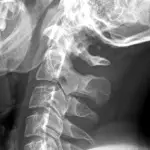Article reviewed and approved by Dr. Ibtissama Boukas, physician specializing in family medicine
Cervical spondylosis is one of the conditions that could be responsible for your neck pain, especially if you are over 40.
What is cervical osteoarthritis and how is it diagnosed? How to recognize its causes and symptoms? And above all, what to do to relieve yourself?
This popular article explains everything you need to know about cervical osteoarthritis. If your doctor has ever given you this diagnosis, you will have answers to all your questions.
Definition and anatomy
Before discussing cervical osteoarthritis (also called cervicarthrosis), it is worth reviewing some notions of anatomy in order to better understand this condition.
The neck is a complex structure made up of vertebrae, discs, nerves, muscles, ligaments and tendons. Because it houses the spinal cord, the cervical region is considered fragile. But it is also remarkably strong because of the stability it provides, and flexible because it allows movement of the neck in all directions.
La cervical spine consists of 7 overlapping bones (called vertebrae), numbered from C1 to C7. Between the vertebrae there are intervertebral discs to absorb shocks and support movements.
How are the vertebrae connected to each other?
On the one hand, the intervertebral disc makes it possible to articulate two vertebrae via their vertebral bodies.
Furthermore, each vertebrate is composed of articular facets called “zygapophysical joints” which connect 2 vertebrae via their posterior arch. Cartilage lines these joints, allowing movement between the vertebrae and avoiding excessive friction.
Like any joint, there can be degeneration over time. This is the phenomenon of osteoarthritis. Osteoarthritis lesions mainly affect the lower cervical vertebrae (C4-C5, C5-C6, C6-C7) and are located at several levels:
- At the level of the discs (causing a compaction and a decrease in space between 2 vertebrae)
- At the facet joints
- At the level of the uncus (between the 3rd and 7th cervical vertebrae)
Bone deformities can then be created. They are called osteophytes, or parrot's beak for their characteristic shape.
Causes of Cervical Osteoarthritis
The exact causes of cervical osteoarthritis are not very well known. Aging seems to be the main cause of cervical spondylosis. As you age, your neck goes through many changes.
- The discs become dehydrated and shrink causing uncomfortable friction between the vertebrae of the neck.
- The bones and ligaments of the neck thicken and encroach on the spine.
- A cervical disc herniation where a crack develops in the disc and presses on the nerves causing numbness and tingling in the hand and fingers.
- Formation of bone spurs (osteophytes): pieces of bone that form on an irritated vertebra (bone growth).
In addition, certain factors could be related to this pathology:
- Age (very common after 60)
- Sex (it affects men more)
- History of neck injury (such as whiplash)
- Repetitive microtrauma of the cervical region
- Temperature (symptoms often aggravated by wet weather, although this is not scientifically proven)
- Malformation of cervical spine
- Deformity as a result of a job or hobby that involves repetitive motions or frequent heavy loads that put more wear and tear on your spine.
Symptoms of the disease
Since cervical osteoarthritis sets in gradually, the body may have been able to adapt over time. Similarly, an absence of inflammation does not cause symptoms.
It is to this extent that we can observe many people with cervical osteoarthritis medical imaging, but feel no pain.
In other cases, however, this condition can be problematic and cause the following symptoms:
- Neck pain and stiffness
- Referred pain in the arm, shoulder, shoulder blade and/or chest
- Numb arms and tingling hands
- Crackles and noises in the cervical vertebrae
- Headache (headache)
Rarely, osteophytes can cause irritation of thevertebral artery surrounding. This is called vertebro basilar insufficiency which can cause the following symptoms:
- migraines and headaches
- Visual disturbances
- Memory problems
- Nausea and vomiting
- Acouphènes
- Hot flashes
- Ringing in the ear
- Tiredness
- Dizziness (to be differentiated with positional vertigo)
What is the link between headache and cervical spondylosis?
Here are 3 causes explaining the potential link between cervical osteoarthritis and headaches:
1. On the one hand, sensory nerves (as the arnold's nerve) connect the scalp to the cervical vertebrae. Thus, when these vertebrae deteriorate, it is possible that these nerves are irritated in the process. This explains the headaches, as well as the jaw pain. This mechanism is called referred pain.
To learn more about Arnold's neuralgia, see the following article.
2. In addition, cervical spondylosis often causes muscle spasms and tension in the suboccipital muscles. This tension frequently radiates to the head (through trigger points causing pain to radiate to the head).
3. Finally, cervical osteoarthritis sometimes causes pain that limits the sleep, causing fatigue, irritability and stress. All of these factors can cause headaches indirectly.
What is the link between vertigo and cervical osteoarthritis?
The dizziness due to cervical spondylosis can be explained by several mechanisms.
From an anatomical point of view, apart from the two carotid arteries, the cervical spine is bordered on each side by a cerebral artery. Their role is to ensure the blood supply to the brain.
In the presence ofcervical spondylosis, these arteries can be compressed, which will cause poor blood flow to the brain, hence the installation of a table ofvertebro-basilar insufficiency. This translates not only into dizziness, but also by loss of consciousness and a serious fall, especially in the elderly.
In case of'early osteoarthritis, it is possible that there is a partial compression of these arteries. Balance disorders may then only occur during certain movements such as rotation, flexion or hyperextension of the neck. They are found mainly in younger subjects.
When cervicarthrosis, un narrowing of the spinal canal can also occur (called narrow cervical canal). This will cause a dysfunction of cervical proprioceptive afferents, hence the appearance of perception disorders aware and unaware of the postures of the different parts of the body, i.e. of the balance.
Moreover, the inner ear (vestibule) proprioceptive systems are in connection with that of the cervical spine. A violation of the latter will therefore certainly have an impact on the vestibular system, which is the balance regulating system.
Diagnosis of cervical spondylosis
The diagnosis of cervical spondylosis always begins with a physical examination. Indeed, although themedical imaging is necessary to identify osteoarthritis, it is more the functional consequences and the symptoms that matter to us.
Thus, the diagnostic examination begins with a medical questionnaire which assesses general health, history of injury, as well as subjective symptoms.
Then, a complete physical examination is used to determine management. During this examination, the healthcare professional checks the following parameters in particular:
- Neurological examination (to rule out serious spinal involvement; This involves reflexes, dermatomes, myotomes, Clonus et Babinsky)
- Flexibility and mobility of the neck.
- Muscular strength and reflexes in the hands, arms or legs.
- Gait (how you walk).
- Trigger points in the neck and shoulder (a knot in the muscles of the neck or shoulder which can cause pain and tenderness).
If dizziness is present, it will first be necessary to ensure that these symptoms do not come from a vestibular or neurological disorder. Precise tests (such as Romberg's test or FuKuda's trampling test) will thus make it possible to eliminate a vestibular cause.
Once this clinical examination is completed, the attending physician may decide to use medical imaging or other paramedical tests. These reports may include the following:
- A radiography showing your neck bones, their alignment, bone loss and bone spurs (if any).
- La computed tomography (CT) provides more detail than X-ray. This scan can help better visualize the spinal canal and bone spurs.
- The MRI images show details of soft tissues such as cartilage, nerve roots, muscles, spinal cord and discs. This test may show spinal compression or herniated disc more clearly than X-ray examinations.
- Other tests may include a myelogram (type of CT scan) or a electromyogram (nerve function test). These tests provide more details about how cervical spondylosis can affect your nerves.
In some cases, MRI might be needed to get more details (such as knowing more about the integrity of soft tissues and/or nerves).
Is it serious: When to worry?
In general, cervical osteoarthritis causes mechanical problems, that is to say, they are related to the movements and various postures of the neck. But sometimes cervical spondylosis has more serious consequences.
Possible complications of cervical spondylosis?
- Inversion of cervical curvature
- Subluxation and cervical dislocation
- Degenerative disc disease
- Cervico brachial neuralgia
- Vertebro-basilar insufficiency
- Radiculopathy cervical
- Myelopathy cervical (most serious complication)
Here are the symptoms of a possible spinal cord injury that constitutes a medical (and sometimes surgical) emergency:
- Tingling, numbness and/or weakness in the arms, hands, legs or feet.
- Lack of coordination and difficulty walking
- Abnormal reflexes
- Muscle spasms
- Loss of sphincter control (urinary and fecal incontinence)
If the patient complains of headaches, care must be taken to exclude a more severe condition (such as a stroke). In this extreme case, the following symptoms could be observed (which require urgent medical consultation):
- facial or generalized numbness
- visual disturbances
- speech changes
- loss of balance
- loss of consciousness
- memory loss
Furthermore, some people wonder if cervical spondylosis can be fatal. In almost all cases, this is not the case.
To maximize recovery and optimize the prognosis, it is important to treat your condition properly. Although cervical spondylosis cannot be corrected without surgery, it is possible to control symptoms and improve quality of life.
Treatment of cervical spondylosis
The treatment of cervical spondylosis is not linear. This means that an approach might work for one person, but not benefit someone else.
Here are the treatment modalities often used to relieve the symptoms of cervical spondylosis:
Rest (Minerva or not?)
In times of crisis, rest can be helpful in relieving pain. On the other hand, it is important to minimize the rest time. This is because the consequences of inactivity can make the condition worse in the long run.
Indeed, inactivity causes muscle atrophy, as well as joint stiffness. These consequences set in gradually, which means that the patient does not realize it.
Thus, it is best to minimize rest as much as possible, and resume activities as soon as possible. Of the medications can also help reduce pain and speed up the return to activity.
With regard to the neck brace, the same philosophy must be followed. Because it immobilizes the cervical region and inhibits muscle activity in the neck muscles, the cervical collar can impede long-term healing.
Thus, as with rest, the neck brace should be used to a minimum, for example during times of crisis or when performing a demanding task (such as cleaning).
Kinesitherapy
The patient suffering from cervical osteoarthritis is often referred to kinesitherapy (physiotherapy). Among the methods used are:
- heat and ice
- Electrotherapy (Tens)
- massages, mobilizations and cervical traction
- Cupping (suction cups)
- Mckenzie method
- Therapeutic exercises
Osteopathy
In addition to the physiotherapist, the osteopath is a professional of choice in the treatment of cervical osteoarthritis.
Although it is impossible to act on osteoarthritis as such, manual techniques can take pressure off irritated nerves, relieve symptoms and relax spasmed muscles.
The holistic approach of the osteopath means that he will work not only the neck, but also the joints and related organs having an anatomical and physiological relationship with the cervical region.
Natural treatment and home remedies
Because conventional treatments do not always offer a satisfactory solution, many people turn to natural treatments and home remedies.
To find out about alternatives to medications and medical treatments, see the following article.
Food
As mentioned previously, it is mainly the inflammation caused by cervical osteoarthritis that is responsible for the pain.
Knowing that certain foods have a pro-inflammatory action and that others have an anti-inflammatory action, it is reasonable to think that an anti-inflammatory diet can help relieve the symptoms of neck pain.
Although this type of diet has mixed evidence, some patients have seen an improvement in their pain after switching to a anti-inflammatory diet.
Yoga
Unlike physiotherapy, yoga does not use therapeutic exercises tailored to the patient's individual condition.
On the other hand, several gestures and postures of yoga allow the improvement of mobility, flexibility, and posture. This can be useful in the presence of neck pain.
Moreover, the therapeutic yoga uses the precepts of yoga to apply it in a rehabilitation context aimed at relieving symptoms and improving function.
Of course, you should consult a yoga specialist to ensure that this practice does not make your symptoms worse.
Pillow (or how to sleep with cervical osteoarthritis?)
When suffering from the neck, the quality of sleep is often affected. To optimize our nights of sleep, an adequate pillow can make the difference.
The orthopedic pillows memory foam have several benefits, in particular because they support the neck by marrying the cervical lordosis. Also, their consistency adapts to all individuals to provide better results.
To know everything about memory foam pillows, consult the opinion of a health professional in next article.
If the symptoms refer to the head and the latter becomes painful on palpation (or causes headaches), it may be appropriate to use a silk pillowcase. Indeed, the silky texture could reduce the irritation and discomfort of the head on the pillow.
As for the sleeping position, it is recommended to sleep on the side with the symptomatic arm at the top if indicated (for example, in the presence of irradiation of pain towards the upper limb). This avoids compression on the side of the pain, and greater freedom of movement of the affected arm. It is also recommended to place a pillow under the armpit on the affected side to provide more support to the shoulder and the scapular region.
Finally, placing heat in the cervical region before sleeping can help relax muscles and improve sleep quality. We recommend 15 minutes with a heat pack before bedtime.
Infiltration
Although infiltration is not the first approach to consider, it can be useful in some cases.
Often, it is the last solution tried before the operation when the symptoms persist, and affects the quality of life.
Most often, cortisone infiltration at the affected level helps reduce inflammation locally, and reduce nerve irritation.
Surgery (when to operate?)
Although it often becomes chronic, cervical spondylosis tends to progress slowly. This means that surgery is rarely necessary.
So, in which case should you operate? As mentioned, there are situations where the spinal cord is affected due to cervical spondylosis. Thus, pfor the the most serious cases as the myelopathy cervical or radiculopathy neck that does not respond to conservative treatment, the doctor may indicate a surgical intervention.
Surgery may involve removing bone spurs, unsoldering the fused vertebrae, or creating more space for the spinal cord. Here are the treatment options from a surgical point of view:
- Laminectomy
- Laminoplasty
- Discectomy
- Foraminotomy
- Arthrodesis
- Flavectomy
- Corpectomy
It should be noted that the optimal surgical technique for treating the spinal compression or nerve roots remains controversial. One approach is not necessarily superior in all circumstances, and the best option will depend on patient-specific anatomical and symptomatic factors.
Spine surgery is complex and can involve a long recovery. The surgeon will examine your symptoms, your general state of health before deciding if an operation of cervical osteoarthritis can be beneficial or not.
Cervical osteoarthritis and sport
Sports to Avoid
Many recreational and even high-level athletes suffer from cervical spondylosis. Thus, physical activity does not necessarily have to be stopped when suffering from this diagnosis.
In times of crisis, however, it is important to avoid activities that aggravate symptoms. Often, sports that impose significant stress on the cervical region should be avoided temporarily. For example :
- Combat sports
- Contact sports
- jogging
- Tennis and other racquet sports
- Gymnastics
- Weightlifting and Crossfit
- Archery
- Etc
However, it must be understood that these sports do not represent an absolute contraindication in the presence of cervical osteoarthritis. In general, your body will show discomfort if you irritate a structure that is fragile. Otherwise, he will adapt and show no pain. This is also the main reason why many cases of osteoarthritis are asymptomatic.
On the other hand, light activities can even help speed healing, as long as the symptoms are not aggravated. For example, walking, swimming (on your back) or suitable weight training can activate blood circulation and lubricate the joints.
So the secret is to go gradually, and make sure you don't cause persistent post-exercise pain. A qualified healthcare professional (such as a physiotherapist or physiotherapist) can help you find suitable exercises, and resume your sports and hobbies without limitations.
Is walking good or bad in case of cervical osteoarthritis?
We tend to think that since cervical spondylosis can cause mobility problems, so avoid moving too much.
On the contrary, it is strongly recommended to do light sports such as marche to prevent and treat all kinds of osteoarthritis. The condition to be respected is that walking does not aggravate the symptoms of neck pain.
The positive effects of walking on cervical spondylosis are many :
- Walking promotes nutrition and mobility of cartilage as it activates blood circulation and optimizes the production of synovial substance.
- Walking helps improve flexibility and correct straight posture
- Walking strengthens the musculoskeletal system
- Walking also effective against pain (by nourishing the cartilage and preventing joint wear)
- Walking promotes autonomy and self-esteem
- The walk does not require any equipment (apart from suitable shoes)
To take full advantage of the benefits of marche, it is advisable to have sessions lasting 30 minutes a day, au less than 5 times per week.
During activities de marche, it is best to start the session with a few minutes of slow walk to warm up (5 minutes is enough). It will be necessary to continue with good steps for several minutes. If necessary, you can interrupt with short breaks every 5 minutes. End the session with a return to slow walking for a few minutes.
You can gradually increase the training time so that it reaches 30 minutes or more.
If it seems too hard, you can spread the walking exercises throughout the day, it would always be beneficial in the face of the cervicarthrose.
It is always best to consult a healthcare professional (such as a physiotherapist or physiotherapist) to establish a safe and progressive plan.
Work stoppage, occupational disease and disability
The question of return to work and disability is often raised in the presence of neck pain.
On the one hand, a work stoppage could be prescribed following a crisis associated with cervical osteoarthritis. The downtime will depend on the symptoms, the condition of the patient and the nature of the work.
Regarding the return, it will also depend on the evolution of the condition. For example, sedentary work will be easier to resume than work requiring heavy lifting or repetitive movements.
Osteoarthritis can be considered an occupational disease under very specific conditions. Indeed, although it is a physiological phenomenon, the wear of a joint is accelerated by certain factors: heavy load bearing, repetitive movement, exposure to mechanical vibrations... If your profession is related to these factors, your osteoarthritis can be considered an occupational disease.
In the case of cervical osteoarthritis, it is quite rare for joint wear and tear to be linked to professional activity. In any case, you should seek the advice of a doctor to find out if you can benefit from coverage and a disability certificate.
Conclusion
Cervical osteoarthritis is a condition that sets in gradually over time, and which causes the degeneration of the joints that make up the cervical spine. Its diagnosis is issued via medical imaging and an associated clinical examination.
Sometimes asymptomatic, it can also cause a lot of pain and functional limitations in some cases.
The treatment of this condition is done after evaluating the symptoms, and will be adapted according to each individual by his treating health professional.
References
https://www.arthrocoach.com/fr/actualites/arthrose-maladie-invalidante-pays-developpes











